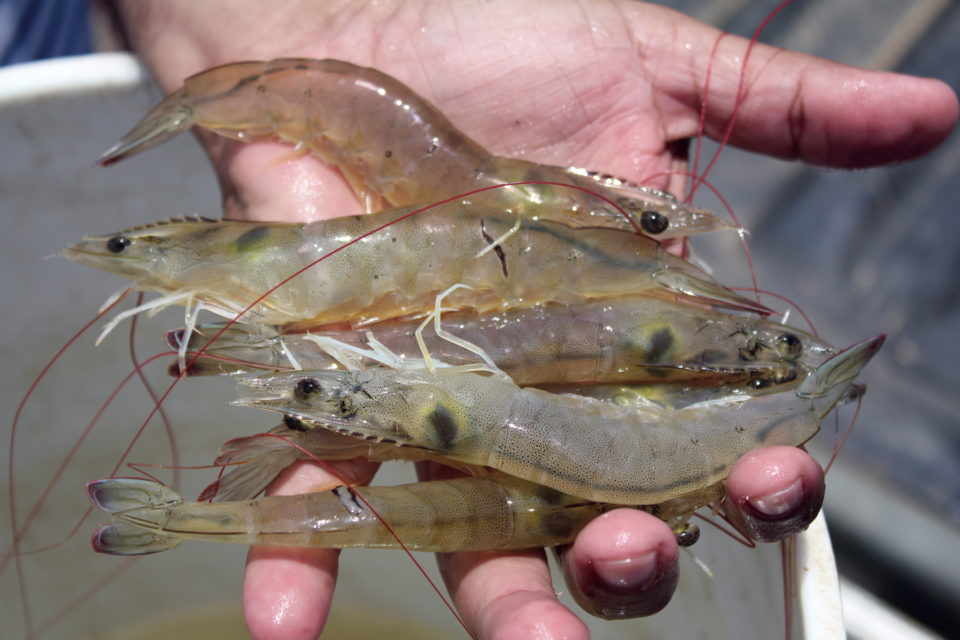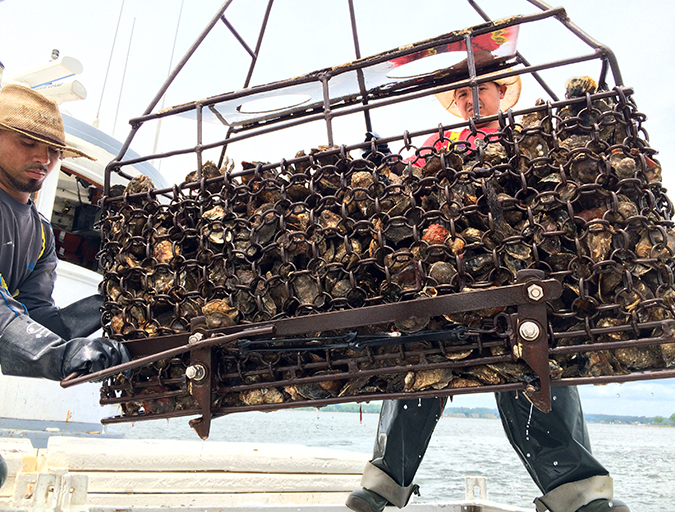Good pond management, stable weather conditions and good water quality can control or prevent many diseases

Farmed shrimp are faced with conditions quite different from their natural marine environments. Disease outbreaks occur not only due to the presence of known pathogens within the culture system, but also due to suboptimal environmental, nutritional, management, genetic or physiological factors.
Multiple pathogens are often present in shrimp pond environments. Multiple secondary infections can therefore occur, sometimes masking the primary cause of disease. With the complexity of shrimp pathogen ecology, it is essential to consider the host, the pathogen and the environment in order to prevent or treat disease conditions.
Global impacts
Historically, some diseases have been endemic to specific shrimp-producing regions and their native shrimp. However, with increased international movement of live animals, different shrimp species – together with their corresponding pathogens – have been translocated among farming regions.
Nowadays, most infectious shrimp diseases can be found in both the Eastern and Western Hemispheres. The Middle East, West Africa and Australia – regions that are relatively new to farming shrimp – have successfully established regulations governing the importation of live and dead shrimp into their respective countries or regions.
Hatchery diseases
Acute diseases responsible for high mortality rates are considered a priority, and efforts are directed toward their prevention or treatment. In contrast, chronic diseases that affect growth and performance tend to be a cause of much less concern to producers, despite their high costs.
The main disease problems at the hatchery level are related to bacterial and fungal infections (Table 1). These can be prevented with proper sanitary measures and water quality management.
Principal shrimp infectious diseases, diagnosis and management
| Hatchery East | Hatchery West | Growout East | Growout West |
|
|---|---|---|---|---|
| Virus | IHHNV | IHHNV | TSV | TSV |
| Virus | HPV | HPV | WSSV | WSSV |
| Virus | B.P. | YHV | YHV | |
| Virus | MBV | IMNV | IMNV | |
| Virus | IHHNV | IHHNV | ||
| Virus | HPV | HPV | ||
| Virus | B.P. | |||
| Virus | MBV | PvNV | ||
| Bacteria | Fouling disease | Fouling disease | Fouling disease | Fouling disease |
| Bacteria | Vibriosis | Vibriosis | Vibriosis | Vibriosis |
| Bacteria | Mycobacteria | Mycobacteria | ||
| Bacteria | NHP | |||
| Bacteria | Mycoplasma | |||
| Bacteria | Streptococcosis | Streptococcosis | ||
| Fungi | Larval mycosis | Larval mycosis | Fusariosis (adult mycosis) | Fusariosis (adult mycosis) |
| Parasites | Fouling disease | Fouling disease | Fouling disease | Fouling disease |
| Parasites | Gregarines | Gregarines | Gregarines | Gregarines |
| Parasites | Microsporidian | Microsporidian | ||
| Parasites | Haplosporidian | Haplosporidian | ||
| Parasites | Metazoan | Metazoan |
HPV: Hepatopancreatic parvovirus
MBV: Monodon baculovirus
B.P.: Baculovirus penaei
T.S.: Taura syndrome
WSS: White spot syndrome
YHV: Yellowhead virus
IMN: Infectious myonecrosis
PvNV: P. vannamei nodavirus
NHP: Necrotizing hepatopancreatitis
Table 1. Disease and virus expression in main shrimp production stages and regions. Sources: Lightner, 1996; Hasson et al., 2009; Senapin et al., 2007.
Enteric viruses can cause high mortalities of shrimp larvae in hatcheries, but again, proper cleaning and disinfection can exclude these viruses. Systemic viruses are not known to cause mortality in shrimp at early stages of life, although they can infect larvae. Both enteric and systemic viruses can be excluded using detection techniques to screen broodstock and thus prevent vertical or horizontal transmission of these pathogens to the larvae.
Production issues
The most serious production losses at the farm level are caused by systemic viruses (Table 1). Viral diseases typically cause high mortalities and generally strike 30 to 40 days after stocking.
Maintaining strict biosecurity and completely excluding pathogens from conventional shrimp ponds are difficult due to the ponds’ size and open exposure. Good pond management, stable weather conditions and good water quality are necessary to control or prevent the onset of many diseases.
Sudden drops in ambient temperature or reductions in salinity due to heavy rains stress shrimp and have been implicated as significant risk factors contributing to disease outbreaks.
Perspectives
Chronic diseases should not be ignored. Enteric viruses, in particular, are associated with poor growth and performance.
To avoid both mass mortalities and impaired performance, it is essential that shrimp are screened during the larval stages to ensure low prevalence of viral pathogens. Bacterial, fungal and parasitic diseases are mostly avoidable with proper management of growout ponds.
The Shrimp Book, published in 2010 by Nottingham University Press (ISBN 978-1-904761-59-4), brings together experts from around the world to fill the critical need for a central reference source on the state of shrimp production practices. With chapters by 67 authors representing the spectrum of shrimp biology and aquaculture – many of whom have contributed to this magazine – the book is addressed to a diverse readership at every step of the shrimp-farming value chain. The editor is well-known shrimp pathologist Victoria Alday-Sanz, DVM, M.S., Ph.D.
Overall, the comprehensive book represents an extraordinary effort by many of the most prominent researchers involved in penaeid shrimp studies. With the permission of the publisher, the Global Aquaculture Advocate is presenting a series of summary articles that highlight chapters from The Shrimp Book. These summaries are meant to provide a glimpse into the vast knowledge available in the book, and by no means can replace actual reading of this excellent publication.
(Editor’s Note: This article was originally published in the May/June 2012 print edition of the Global Aquaculture Advocate.)
Authors
-
Jorge Cuéllar-Anjel, DVM, M.S.
Director, Shrimp Pathology and Research Department
Camaronera de Coclé S.A.
Apartado 0823-05819
Panama City, Panama[116,101,110,46,97,115,117,64,110,97,117,99,111,106]
-
Mathias Corteel, DVM, Ph.D.
Director of Production
Aquapesca Ltd.
Quelimane, Mozambique -
Leonardo Galli, DVM, M.S.
Laboratory of Virology
Faculty of Veterinary Medicine
Ghent University
Merelbeke, Belgium -
Victoria Alday-Sanz, DVM, M.S., Ph.D.
Aquatic Animal Health
Barcelona, Spain -
Kenneth W. Hasson, M.S., Ph.D.
AquaDiagnostics
College Station, Texas, USA
Tagged With
Related Posts

Health & Welfare
A comprehensive look at the Proficiency Test for farmed shrimp
The University of Arizona Aquaculture Pathology Laboratory has carried out the Proficiency Test (PT) since 2005, with 300-plus diagnostic laboratories participating while improving their capabilities in the diagnosis of several shrimp pathogens.

Health & Welfare
A holistic management approach to EMS
Early Mortality Syndrome has devastated farmed shrimp in Asia and Latin America. With better understanding of the pathogen and the development and improvement of novel strategies, shrimp farmers are now able to better manage the disease.

Responsibility
A look at various intensive shrimp farming systems in Asia
The impact of diseases led some Asian shrimp farming countries to develop biofloc and recirculation aquaculture system (RAS) production technologies. Treating incoming water for culture operations and wastewater treatment are biosecurity measures for disease prevention and control.

Intelligence
As ocean temperatures rise, so too will vibrio outbreaks
A study using a half-century of data has linked climate change and warming sea temperatures with an increase in illnesses from the common vibrio bacteria. Shellfish growers, fighting a particularly virulent strain of Vibrio parahaemolyticus, are changing their harvest protocols.


